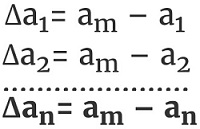Units and Measurements - Online Test

Parallax Method of Measurement : Astronomers use an effect called parallax to measure distances to nearby stars. Parallax is the apparent displacement of an object because of a change in the observer's point of view.
To measure the distance D of a far away planet S by the parallax method, We observe it from two different positions (observatories) A and B on the Earth, separated by distance AB=b at the same time as shown in the given figure.
We measure the angle between the two directions along which the planet is viewed at these two points. The ∠ASB in the figure represented by symbol θ is called the parallax angle or parallactic angle.
As the planet is very far away, bD<<1 and therefore, θ is very small. Then we approximately take AB as an arc of length b of a circle with center at S and the distance D as the radius AS=BS so that AB=b=Dθ where θ is in radians.
Absolute error is defined as the magnitude of difference between the actual and the individual values of any quantity in question.
Say we measure any given quantity for n number of times and a1 , aa2 , aa3 ….. an are the individual values then Arithmetic mean
am =( [a1+a2+a3+ ….. + an]/n )
Now absolute error formula as per definition

Δamean=(|Δa1|+|Δa2|+|Δa3|+...+|Δan|)
Mean is the average of all numbers. So mean of all the absolute errors will be given by
Relative Error or fractional error : It is defined as the ration of mean absolute error to the mean value of the measured quantity.
Percentage Error: It is the relative error measured in percentage.
So Percentage Error
%
When two quantities are added or subtracted, the absolute error in the final result is the sum of the absolute errors in the individual quantities.
e.g: error in the sum x=a+b is
maximum value of error =
When two quantities are multiplied or divided, the relative error in the result is the sum of the relative errors in the multipliers.
e.g x=a x b
maximum possible error is:
similarly, for error in quotient: x=
maximum possible error is:
The relative error in a physical quantity raised to a power k is the k times the relative error in the individual quantity.
for e.g.
maximun relative error,
The significant figures of a number are digits that carry meaning contributing to its measurement resolution. This includes all digits except:
- All leading zeros;
- Trailing zeros when they are merely placeholders to indicate the scale of the number (exact rules are explained at identifying significant figures); and
- Spurious digits introduced, for example, by calculations carried out to greater precision than that of the original data, or measurements reported to a greater precision than the equipment supports.
